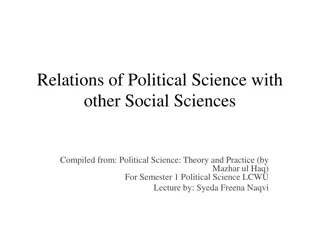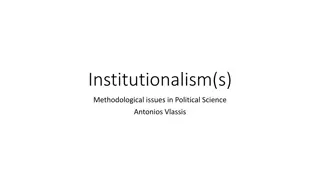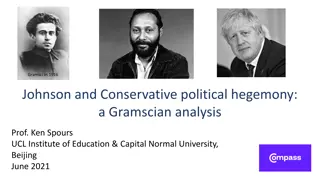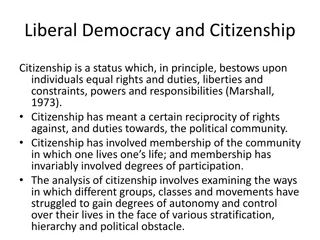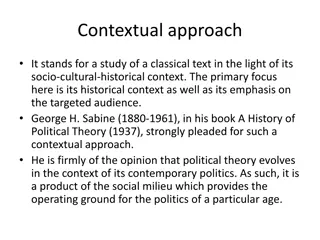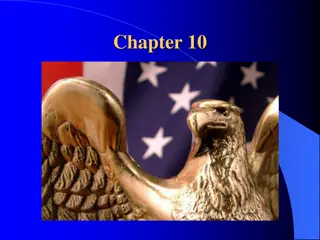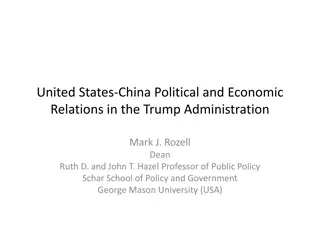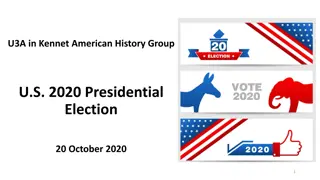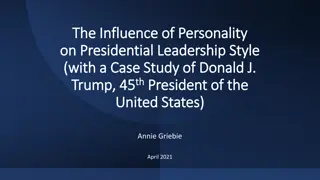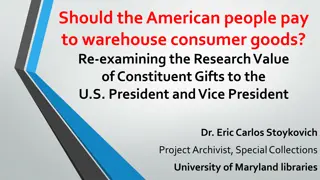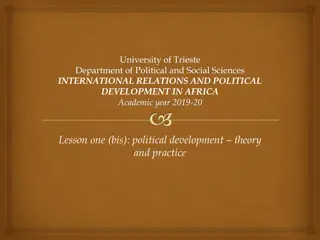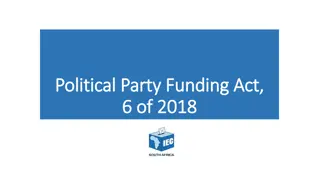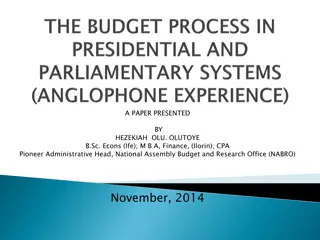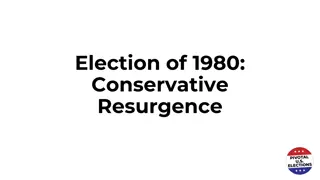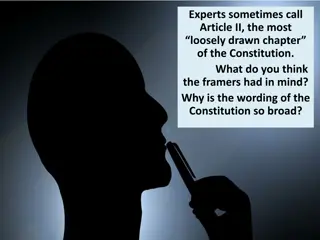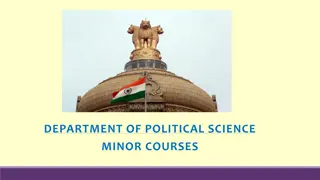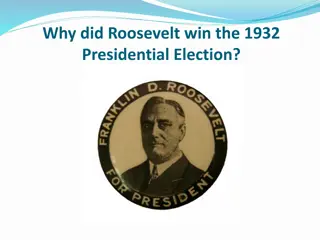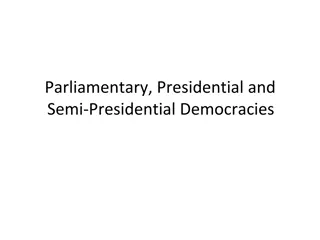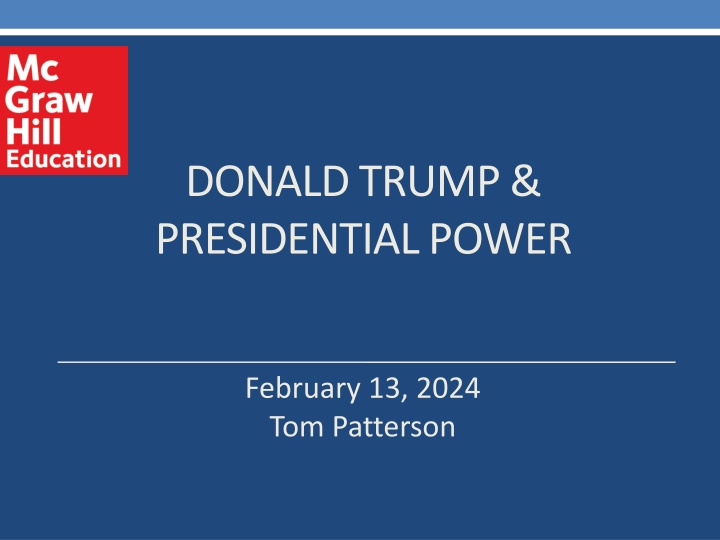
Presidential Power Dynamics & Political Environments
In this content, delve into the contrasting approaches to executive power by Presidents Donald Trump and Franklin D. Roosevelt, highlighting their interactions with Congress, the Supreme Court, and their strategies for governance. Explore the implications of their political environments on policy actions, executive orders, agency regulations, and government structure reshaping efforts.
Download Presentation

Please find below an Image/Link to download the presentation.
The content on the website is provided AS IS for your information and personal use only. It may not be sold, licensed, or shared on other websites without obtaining consent from the author. If you encounter any issues during the download, it is possible that the publisher has removed the file from their server.
You are allowed to download the files provided on this website for personal or commercial use, subject to the condition that they are used lawfully. All files are the property of their respective owners.
The content on the website is provided AS IS for your information and personal use only. It may not be sold, licensed, or shared on other websites without obtaining consent from the author.
E N D
Presentation Transcript
DONALD TRUMP & PRESIDENTIAL POWER February 13, 2024 Tom Patterson
We the People, 2025 NUMBER ONE the top-selling American Government text Noted for Its Readability a text that students actually like to read To obtain a free instructor s copy of We the People, please email polisci@mheducation .com Emphasis on Critical Thinking turning students from passive readers to active ones Balanced there are two sides to American politics Unparalleled Instructor Support Connect, Smartbook, Videos, Podcasts, News Alerts, and more
DONALD TRUMP & PRESIDENTIAL POWER February 13, 2024 Tom Patterson
Franklin D. Roosevelt The last president who sought to thoroughly redefine federal and executive power. During Roosevelt s pre-war presidency: Federal civilian employment nearly doubled from 600,000 in 1932 to 1,100,000 in 1941 69 new federal agencies (e.g., Social Security Administration, FDIC, SEC, FCC) were created Executive Office of the President (EOP) was created (Executive staff rose from 109 in 1932 to 21,428 in 1941).
Roosevelts Political Environment Democratic majorities in Congress 71% of House seats in 1933, rising to 78% in 1937 61% of Senate seats in 1933, rising to 79% in 1937 An obstructionist Supreme Court Repeatedly struck down New Deal legislation (8 acts in its 1935-36 term alone) until 1937 when the stitch in time that saved 9 ended judicial opposition.
Donald Trump My administration [will} dismantle government bureaucracy, slash excess regulations, cut wasteful expenditures, and restructure federal agencies.
Donald Trumps Political Environment Narrow congressional majorities 53-47 in Senate (not filibuster proof) and 218- 215 in the House. Perhaps, a compliant Supreme Court (6 Republican appointees, 3 of whom are Trump appointees)
TODAYS TOPICS Executive Policy Action Executive Orders Agency Rules Deportations Downsizing Government
Trumps Executive Orders Since his inauguration, President has signed dozens of executive orders and presidential memoranda on topics including energy and the environment; immigration; international trade; foreign policy; diversity, equity and inclusion (DEI); transforming the civil service and federal government; and technology, as well as rescinding many of Biden s executive orders.
Presidential Executive Orders To be lawful, an executive order must take place within context of a law; cannot clearly violate a law s provisions; (theoretically) comply with the President s constitutional duty to "take Care that the Laws be faithfullyexecuted.
Example of a Trump Executive Order likely to upheld Ends diversity, equity and inclusion initiatives and related programs in the federal government These programs were established through executive action and, given the Supreme Court s affirmative action ruling (Students for Fair Admissions v. Harvard (2023)), a legal argument against it would be unlikely to succeed.
Example of a Trump Executive Order likely to be voided Ending birthright citizenship 14thAmendment: All persons born or naturalized in the United States, and subject to the jurisdiction thereof, are citizens of the United States and of the State wherein they reside. In adjudicating this, the courts likely would invoke the plain meaning rule to invalidate the Executive Order.
14 Courts have recently shown less deference to Executive Orders Examples: Obama on granting undocumented a grace period on deportation Trump on blocking entry from Muslim countries Biden on Covid-19 vaccine mandates
Regulatory Rollback Rules and regulations that Trump Administration sought to overturn during first year in office (2017) Trump targeted areas where he believed federal bureaucrats were pursuing a liberal agenda Source: NY Times, 1/20/18
The Administrative Procedures Act of 1946 (note APA applies only to agency rules, not executive orders) Establishes the procedures agencies must follow when changing the rules. Example procedures: Publishing notice of a proposed rule in the Federal Register Allowing for a public comment period on proposed rules & taking those comments into account in finalizing a rule Allowing for a delay between publication of a final rule and its effective date,
Judicial Action The Administrative Procedures Act of 1946 The APA authorizes federal courts to review administrative action for compliance with APA and to set aside agency action deemed unlawful because it is: arbitrary, capricious, an abuse of discretion, or otherwise not in accordance with law; contrary to constitutional right, power, privilege, or immunity; in excess of statutory jurisdiction, authority, or limitations, or short of statutory right without observance of procedure required by law 1. 2. 3. 4.
How Trump Administration Fared under the APA in His First Term Percentage of APA court rulings upholdingthe Administration s actions recent presidents 70 The rulings against the Trump administration usually involved violation of law, failure to follow procedure, and inadequate justification for the action. In most cases, APA suits are decided at the district court level, only rarely by Supreme Court Donald Trump 6 Source: Washington Post, first two years of Trump presidency
A 2024 Supreme Court ruling restricts agency discretion in rulemaking In 2024 (Loper Bright Enterprises v. Raimondo), the Supreme Court effectively voided the Chevron doctrine (Chevron v. Natural Resources Defense Council (1984)), which required courts to defer to an agency's reasonable interpretation of ambiguous statutes. Under Loper Bright, courts are now obligated to independently interpret statutory provisions and cannot simply defer to an agency's interpretation.
22 Trump s Executive Order Strengthens immigration enforcement by directing that immigration laws be strictly enforced. The executive order is lawful. Deportations of those in the U.S. unlawfully are permitted under federal law.
Deportations, by presidential term Number of deportations (in thousands) 4,889 3,178 2,111 2,004 2009-2012 (Obama1) 2013-2016 (Obama2) 2017-2020 (Trump) 2021-2014 (Biden)
The restraints on a presidents deportation order are in its implementation Trump has pressured state and local officials to assist in the deportations by arresting and holding undocumented persons they detain. And he s threatened to withhold federal aid from sanctuary states and cities.
If precedent holds, Trump doesnt have the authority to do either of those things Requiring state & local cooperation. In Printz v. United States (1997), the Supreme Court established the "anti- commandeering" doctrine. It holds that the federal government cannot force state and local officials to carry out a federal program. Withholding federal funds: In San Francisco v. Trump (2018), the Ninth Circuit Court voided a Trump executive order withholding federal funds from sanctuary cities that did not share immigration status information with federal authorities. The majority noted that no such condition was attached by Congress for eligibility for the funds.
Nevertheless - The first policy Act of the new Congress (The Laken Riley Act of 2025) requires U.S. Immigration and Customs Enforcement (ICE) to detain and repatriate illegal aliens who commit theft, burglary, larceny, shoplifting, assault against police officers, and crimes that result in serious bodily harm or death. Nearly all the crimes identified in Laken Riley involve violation of state and local law rather than federal law, which would seem to require state and local cooperation.
Response to Laken Riley Act In some Republican-controlled states (e.g., Florida), state and local law enforcement have been ordered to comply with the confinement mandate. In some Democratic-controlled states and cities (e.g., Illinois, San Francisco), law enforcement officials have been ordered not to comply. Yesterday, the Trump administration froze federal aid to sanctuary cities for 60 days pending a review of the conditions attached to the aid.
Removal of Political Appointees President can remove nearly all political appointees at will meaning, without cause. However, some political appointees are in a protected category they can only be fired for cause
Protected Appointees? On January 29, Fed Chair Jerome Powell announced the Fed was hitting pause on further reductions in the interest rate. Trump then hinted that he might remove Powell as chair of the Fed. Those already holding for cause positions who ve been fired: Head of DOJ s Office of Special Counsel NLRB member Two EEOC members
Legal Precedent In Humphrey s Executor v. United States (1935), the Supreme Court ruled in a case where President Franklin Roosevelt had fired William Humphrey, a conservative commissioner on the Federal Trade Commission, over policy differences. Humphrey died shortly after his dismissal, but his executor sued for damages. The Court ruled in favor of the executor, saying the Constitution does not give the president illimitable power of removal.
Will the precedent hold? A test case has been teed up. Gwynne Wilcox, the fired member of the NLRB, has filed suit contesting her firing. In Seila Law v. Consumer Financial Protection Bureau (2020), the Supreme Court by 5-4 (Roberts and the 4 Democratic appointees in the majority) ruled that the for cause aspect of the position violated the separation of powers and that then President Trump had the authority to fire the director. However, the majority said that Humphrey s Executor still stood and applied to multi-member agencies like the FTC. On the other hand, that position was opposed in dissent by Court conservatives. Moreover, since 2020 Ginsburg has been replaced by Coney Barrett, which could shift the Court to a 5-4 majority that would make all executive appointments at will.
Downsizing the Federal Government
Four Considerations Here 1. Can the president offer deferred buyouts to federal employees? 2. Can the president unilaterally eliminate a federal agency? 3. Can the president reclassify civil servants for the purpose of terminating them? 4. Can the president withhold federal funding to eliminate a program or policy?
Deferred Buyouts On Jan. 28 by email, roughly 2 million federal employees deemed eligible for deferred resignation were contacted. If they resigned, they would be exempted from all in-person work requirements and would collecting salaries and earning benefits through Sept. 30. Those resigning had to agree to forever waive, and not pursue through any judicial, administrative, or other process, any action against their agency. They were given under February 6 to resign or lose the opportunity.
Is the buyout legal? Questions about it: 1. Does a president have the authority to make such an offer? Congress didn t appropriate the money with the expectation workers wouldn t show up to work. 2. The government is funded only through mid-March. Would workers have recourse if the money isn t appropriated? Only hours before the resignation deadline, a federal judge halted the program. Yesterday, he ruled that the plaintiffs (federal workers unions) lacked standing and allowed the program to continue. New lawsuits have been filed, unclear as to whether they will succeed.
Elimination of Federal Agencies By law, a federal agency can be eliminated and all its employees terminated. But: 1. It requires an act of Congress; 2. Must be conducted according to set procedures, including a "Reduction in Force" (RIF) process that considers factors like tenure, veterans' preference, and performance ratings when deciding which employees are let go. 3. Qualified individuals are eligible for reassignment to other agencies if there are vacancies.
Elon Musk, DOGE, and USAID By law, it would appear Elon Musk (or Donald Trump) cannot unilaterally eliminate USAID and terminate its employees. A federal judge on Friday granted a temporary restraining order, halting the Trump administration s placement of 2,700 USAID employees on paid leave and ordering those overseas to return to Washington within 30 days, The suite was brought by the American Foreign Service Association and the American Federation of Government Employees. The federal judge who issued the ruling is Carl J. Nichols, a Trump appointee from 2019. A hearing on extending the order was yesterday. Nichols has not yet issued a ruling.
Nevertheless Presidents have some authority to reorganize the federal branch which could extend to placing some of USAID s programs under the State Department. (Secretary of State Rubio has assumed the position of acting director of USAID.) Congress has a consultive role in the process, but it would have to act to prevent it (whereas inaction on the elimination of USAID would preserve it).
Reclassifying Civil Servants Late in his first term, Trump signed an executive order creating Schedule F as part of the civil service. Such employees could be assigned at will, and fired at will Biden rescinded the executive order upon taking office. A pending court case on the legality of Schedule F was dismissed as moot after Biden rescinded Trump s order.
Bringing Back Schedule F (renamed as Schedule Policy/Career) On the first day of his second term through an Executive Order, Donald Trump reauthorized Schedule F, saying it would cover as many 50,000 federal employees. Is it lawful? Lawsuits have been filled that allege it is contrary to what Congress intended in establishing the civil service, treats civil servants like political appointees, and violates Office of Personnel Management regulations regarding protection of civil servants from arbitrary action. The Trump Administration argues that Schedule F employees occupy policy-influencing positions and therefore do not meet the non-partisan neutrality principle underlying the civil service. A lawsuit has been filed by the American Federation of Government Employees (AFGE).
Federal Funds On Trump s first day in office, the Office of Management and Budget (OMB) issued a freeze on all federal grants and loans. Almost immediately, a federal judge issued a stay on the order. The same day, OMB rescinded its order. However, some funding (e,g, USAID, DEI, Green New Deal) has been slowed or suspended.
The Impoundment Control Act of 1974 The ICA created a process for Congress to review a federal agency's withholding of funds that were approved by Congress. The act allows a president to withhold funds in specific circumstances (for example, efficiency but not to achieve policy goals) for a limited period (up to 45 days)and requires the president to send a special message to Congress explaining the action. Congress then decides whether to allow spending to be deferred or rescinded. Unless it acts, the spending goes forward.
Is the ICA Constitutional? The Trump administration argues that the law is an unconstitutional intrusion on executive authority claiming the President cannot spend more than Congress appropriates but has the authority to spend less. The constitutionality of the Impoundment Control Act has not been ruled on by Supreme Court. In Train v City of New York (1975), the Supreme Court ordered the executive to spend an appropriation, but the class was decided on statutory grounds the statute expressly indicated all funds were to be spent.
The Known Unknowns at this point in Donald Trump s efforts
Open Questions 1. The current Supreme Court has frequently overturned precedent on major issues (e.g., abortion, affirmative action, presidential immunity) and has typically done so in ways aligned with Republican Party goals. However,except for the presidential immunity ruling, it s tended recently to place greater limits on unilateral presidential action. 2. The Trump Administration has an expansive view of the Court s immunity ruling claiming it gives the President discretion in enforcing the law that is beyond the review of Congress and the courts. (TikTok as an example.) 3. It s unclear that the Trump Administration in all cases will obey Court rulings. (Despite the judicial hold on the spending freeze, some spending remains frozen.) 4. Historically, the courts have had limited ability and limited interest in enforcing governing norms as opposed to actual laws.
Thank You. Questions, Observations, Objections?

